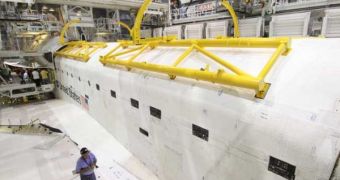Mission planners at NASA are currently in doubt whether the space shuttle Atlantis will be able to launch on November 12, as originally planned. Apparently, the increased space traffic, incoming meteor showers, and a very narrow launch window may force officials to either delay the launch, or move it to next year altogether. The STS-129 mission, or ISS assembly flight ULF3, will fly to the International Space Station laden with spare parts and equipment, which the astronauts will affix to external cargo bays over the course of three spacewalks, Space reports.
Adding to the complexity of the situation is the fact that, between November 21 and December 5, the orbital facility will receive sunlight from an angle that will not allow it to generate sufficient electricity to support a docked shuttle. Additionally, the station would be unable to dissipate the heat that such a maneuver would generate. When Atlantis lifts, it will only carry six astronauts, as opposed to the usual seven. The new Expedition 21 members took off on the Soyuz TMA-16 space capsule, and are already aboard the sky lab.
The shuttle needs to be away from the ISS by November 21, which gives NASA a very narrow window of opportunity. If that is missed, another launch attempt could only take place between December 6 and December 13. Atlantis needs to be off the ISS by December 23, when a Russian Soyuz capsule brings in replacements for the station's crew. The next launch opportunity would then open on January 7, 2010. NASA is trying to avoid flying its shuttles on New Year's Eve, because the onboard computers are not designed to handle year swapping in mid-flight.
There are other obstacles at work as well. On November 17, the Leonid meteor shower will peak, followed by the Geminids, on December 13-14. A new communication satellite will be launched from a United Launch Alliance Atlas 5 rocket on November 14, followed, four days later, by a Delta 4 rocket launch. To top things, the US Air Force Eastern Range, the installation that provides space-tracking capabilities for all launches from the Kennedy Space Center and the Cape Canaveral Air Force Station, in Florida, needs between 24 and 48 hours to reset its systems.
Upon return, Atlantis will bring home NASA astronaut Nicole Stott. In spite of the fact that the Canadian Space Agency's (CSA) Robert Thirsk was scheduled to return home with STS-129, flight delays have prompted a swap. Thus, Stott will fly home in Atlantis, and Thirsk will descend in Kazakhstan, aboard the Soyuz TMA-15 spacecraft.
Among the most important instruments that will be taken to the ISS, mission controllers will include two spare gyroscopes and two nitrogen-tank assemblies, alongside two pump modules, a high-pressure gas tank, a spare-trailing umbilical system for the Mobile Transporter, and an ammonia-tank assembly. The payload bay's two External Logistics Carriers will also include food, scientific equipment and other supplies for the station's permanent, six-astronaut crew. If NASA sticks to its plans of withdrawing the shuttles at the end of this year, then only six shuttle flights remain, STS-129 included.

 14 DAY TRIAL //
14 DAY TRIAL //